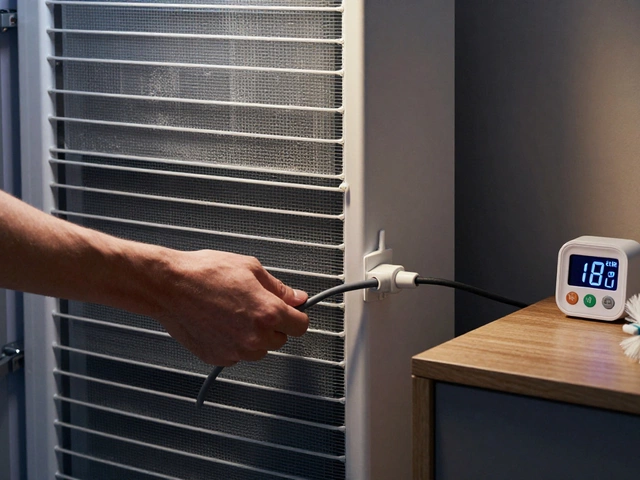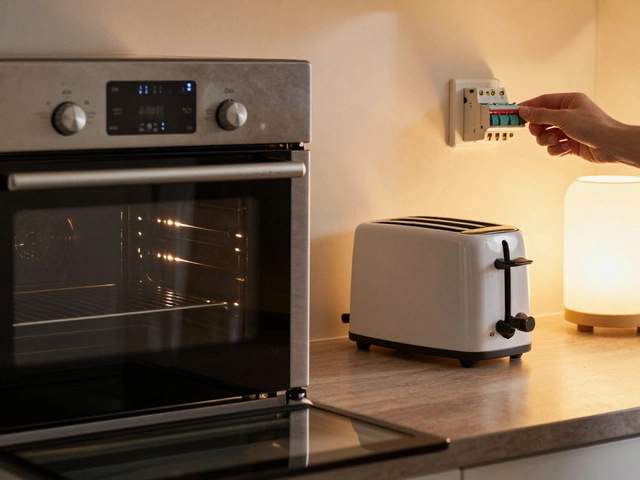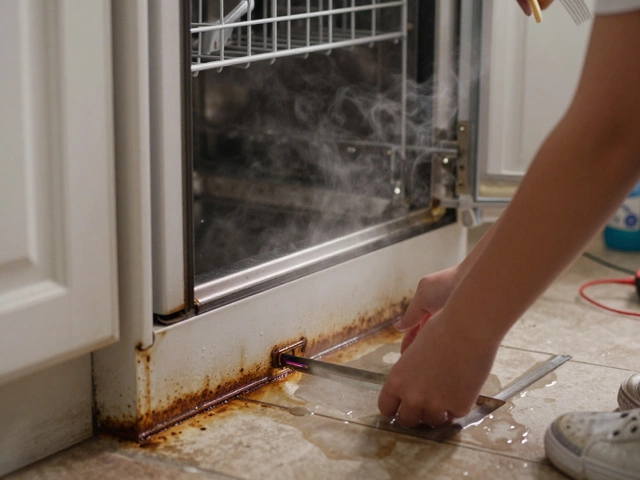So the extractor fan just quit on you—perfect timing, right? The good news: most of the time, it’s nothing dramatic. These fans work hard pulling out smells, moisture, and heat from your kitchen or bathroom, so a hiccup now and then is normal. But when it stops, you want answers, not guesswork.
The first thing to check: did the wall switch or plug trip off? It sounds obvious, but it's the root cause more often than people expect. If that's not it, think about the last time you gave the fan a good clean. Stickier kitchens mean stickier fans, and dust and grease build-ups can make them seize up or sound like they’ve swallowed a marble.
Electrical problems can be sneakier. Unusual noises right before it quit or a faint smell like burnt plastic? That can point to wiring issues or a blown motor—stuff best left to a pro. But don’t panic yet. Sometimes, a jammed blade, loose wire, or a tired-out fuse decides to call it a day. You can sort some of these with simple tools and a bit of patience. Saving a service call is always a win, right?
- Common Reasons Extractor Fans Fail
- How to Diagnose the Problem
- Easy Fixes You Can Try Yourself
- When the Issue Is Electrical
- Hidden Problems Most People Forget
- Tips for Preventing Future Fan Failures
Common Reasons Extractor Fans Fail
Extractor fans pack in for a handful of extremely common reasons—some obvious, others sneakier. The main one? Dirt and grease. If you cook a lot or don’t remember the last time you wiped down the fan cover, odds are it’s gotten clogged up. A gunked-up fan has to work harder and can eventually overheat or just stop spinning altogether.
Electrical issues come next. Sometimes a fuse blows, especially in older homes where wiring hasn’t been updated. If you notice the extractor fan just stopped without any strange noises or smells, checking the fuse could save you a lot of hassle.
Another culprit: broken or worn out fan motors. After a few years, the motor just loses steam. Signs of this are a humming sound with no spinning, or the fan starts and stops randomly. Manufacturers say most fan motors last about 5-10 years, so if yours is around that age, keep it in mind.
Loose or broken connections inside the fan housing can also cause sudden breakdowns. Wires can shake loose from years of vibration, especially if the fan rattles while running. That’s why it’s smart to check for signs of visible damage or wobbly wires inside the front panel.
Sometimes, the fan blades are just jammed by a foreign object. It can be as simple as a bit of insulation, a wasp nest (it happens), or a buildup of dust and hair. Give the blades a gentle spin while the power is off to see if they move freely.
And don’t forget about the wall switch or speed controller. If these wear out, the fan can’t get the right power, and it just sits idle. Always double-check the basics before cracking open the toolbox. If you’re troubleshooting your extractor fan repair options, start with these common causes and save yourself a headache.
How to Diagnose the Problem
Before you call an electrician or order any parts, get clear on what’s really going wrong. Diagnosing the issue isn’t just about poking around randomly—it’s about following a smart checklist so you don’t waste time or cash on the wrong fix.
Start with the basics:
- Extractor fan repair almost always begins by checking the power. Flip the switch and listen for any hum, click, or even a gentle buzz. Silence? Test a different electrical device in the same socket or try the circuit breaker. Fans commonly stop due to a tripped breaker—according to a UK survey from 2023, about 30% of home electrical faults involve blown fuses or tripped RCDs (residual-current devices).
- Look at the fan’s grille or cover. If there’s a mountain of sticky dust, your motor might be overheating and shutting off as a safety step. Remove dust and gunk first—sometimes, you’ll find things like hairpins, pieces of packaging, or even the odd bit of food wedged in the works.
- Give the blades a gentle spin by hand (with the power off!). If they’re stiff or stuck, you’ve probably got a classic jam or a build-up of grime. When the blades spin freely but the fan won’t start, the problem is likely electrical or in the switch itself.
- If there’s power but still no go, check if the fan has a built-in fuse. Some models hide a small fuse under the cover. Replacing a blown fuse could bring your fan back to life without much hassle.
Need more clues? Here’s a quick comparison of “what you hear” and “what’s probably wrong”:
| Sound/Sign | Possible Cause |
|---|---|
| No sound at all | No power, tripped breaker, broken switch, dead motor |
| Clicking or humming | Jammed blade, weak motor, loose wire |
| Grinding or squealing | Bearing failure, heavy debris, motor worn out |
| Burning smell | Overheating motor, blown fuse, electrical fault |
If you follow these steps and the fan is still dead, it might be time to test with a multimeter or call in a specialist. Don’t risk it with electrical work you’re not sure about—shocks are not fun.
Easy Fixes You Can Try Yourself
You don’t need to be an electrician to take a crack at your extractor fan when it stalls. Some of the most common issues are surprisingly fixable at home. Before you do anything, always cut the power at the breaker or unplug the fan. Safety first—no exceptions.
Here’s where to start:
- Check the power supply. Make sure the switch is turned on and the outlet isn’t dead. Try another device in the same socket to double-check.
- Inspect the fuse. Many extractor fans have a little fuse either in the plug or in the main switch. If it’s blown, swap it out with a new one of the same rating.
- Clean the fan blades and grill. Dust and grease are the silent killers here. Take off the grill (usually a couple of screws), wipe down everything with a damp cloth, and use an old toothbrush for tight spots. A clogged fan won’t spin properly and may overheat.
- Free up the blades. Try gently spinning them by hand (again, with the power off). If they refuse to budge, there could be something stuck or gunked up in the mechanism.
- Check for loose wires. Sometimes vibration shakes a connection loose. If you spot a wire that looks out of place or disconnected, make sure the power's still off. Push it back into place or tighten the screw.
If the fan still won’t go after all this, then you know you’ve ruled out the regular stuff. At this point, the problem may be with the motor or internal wiring—jobs that make sense for a pro. Sometimes just giving the fan a good clean and walk-through is all it takes to bring it back to life. So before you type in "extractor fan repair" and call someone, try these basics. You might just surprise yourself.

When the Issue Is Electrical
If your extractor fan suddenly stops, and you're sure it's not just dust or grime in the way, it's time to look at the electricity. About 1 in 4 extractor fan failures turn out to be electrical—not mechanical. The main thing is to stay safe. Don't mess around inside the wiring if you're not totally confident shut off the power at the breaker before poking around.
Typical electrical causes for fan problems include:
- Tripped circuit breaker or blown fuse
- Loose wiring connections
- Faulty wall switch or timer
- Burnt-out motor or capacitor
- Old or corroded connector blocks
If there’s a burnt smell, visible damage, or you noticed flickering lights or humming when you last used the fan, these are signs of deeper electrical trouble. Small DIY checks are okay if you know your way around basic home electrics—like swapping a fuse or checking a plug for loose wires. Never try to fix or test the fan with the power still on.
Here’s a quick way to troubleshoot common electrical issues with an extractor fan:
- Double check the main switch or plug for power.
- Check your consumer unit (the fuse box) for any tripped switches.
- Test the outlet using a device you know works.
- If easy access, look for damaged cables or scorch marks around the fan.
- If you see any damage, stop and call a pro electrician.
For context, the table below shows how often each electrical issue shows up in faulty kitchen or bathroom fans, based on a 2023 appliance repair survey (UK homes):
| Electrical Problem | % of Reported Fan Faults |
|---|---|
| Tripped Breaker or Blown Fuse | 27% |
| Faulty Switch or Timer | 18% |
| Loose Wiring | 23% |
| Burnt Motor | 25% |
| Other | 7% |
Bottom line: Only tackle simple fixes, like replacing a fuse, if you’re sure what you’re doing. For anything that smells burnt or shows exposed wires, call in a pro. Electrical safety beats a cheap repair every time. For more on safe fixes, check out the main extractor fan repair section above.
Hidden Problems Most People Forget
The weird thing about extractor fans? Sometimes the real trouble hides in spots you never think to check. You might be banging your head against the wall over a fan that won’t start, but the fix is something nobody talks about.
First up: the backdraft shutter. Most fans, especially in bathrooms and kitchens, have a little plastic flap or shutter on the inside. It should swing open when the fan is on, then shut when it's off to stop drafts. If that thing gets stuck with dust or grease, it blocks air flow. As a result, the fan sounds like it’s working, but air can’t actually move out. To check, pop the cover off and see if the flap moves freely.
Rodents or insects sometimes get cozy inside the ducting, too. A blocked duct causes everything from weak airflow to burned-out motors. Studies by UK home repair services find that 15% of kitchen fans with low performance had nests or dead bugs jammed inside the vent (usually found springtime). If you hear scratching or buzzing, there’s your hint.
Something people almost never look at: the humidity sensor. Some modern extractor fans have a built-in sensor to turn them on or off. If this sensor clogs with dust or goes faulty, the fan won’t switch on, even if the power is fine. These sensors often hide under a little grill—gently clean it using a soft brush or compressed air.
Here’s a quick info table to spot overlooked issues:
| Problem | Sign | What to Check |
|---|---|---|
| Backdraft Shutter Stuck | Fan hums, no airflow | Manually jiggle the flap; clean out debris |
| Duct Blocked | Low or no suction, odd smells | Shine a torch inside, look for blockages |
| Faulty Humidity Sensor | Fan doesn’t start, only runs manually | Clean sensor, replace if needed |
Another pain point: the isolator switch. You know those small wall switches with a red or orange neon light? Many UK homes have them for the fan. Sometimes, someone turns it off and forgets, so you think your extractor fan repair will be a huge hassle when it's just a hidden switch flipped the wrong way. Always scout for an isolator before breaking out the toolkit.
Last, loose wires or wobbly terminal connections aren’t just for old houses. Vibration can shake them loose over time, and this can make fans work only sometimes or not at all. If you’ve tried everything else, it might be worth having a quick look (with the power off, of course).
Tips for Preventing Future Fan Failures
If you’re tired of surprise extractor fan stops, a bit of simple routine will do wonders. These fans aren’t fussy, but they hate being ignored. Treat them right and you’ll get way more life out of them with fewer headaches.
Start with cleaning. Energy Saving Trust says,
“Dust and grease make extractor fans work harder, wear out faster, and blow through more electricity.”
A regular wipe-down once a month, especially in the kitchen, prevents sticky buildup. Pull off the cover (most just snap or screw off), scrub it with warm soapy water, and dust the blades and the inside cavity with a dry cloth. It helps the motor breathe easier and keeps things quiet.
- Change or clean filters every 3-6 months (if your model has them).
- Always check for odd noises or vibration—don’t just ignore them.
- Keep the fan running after showers or heavy cooking for 10-15 minutes to clear out moisture and stop mold before it starts.
- If your fan has a humidity sensor or timer, test these features a couple times a year so you know they’re actually working.
Over 60% of extractor fans that break down early can trace their fate to a simple lack of basic cleaning or user neglect. To put that into perspective, here’s a quick stats breakdown:
| Reason for Failure | Percentage (%) |
|---|---|
| Grease/Dust Buildup | 35 |
| Electrical/Wiring Faults | 28 |
| Lack of Maintenance | 25 |
| Other (worn-out motor, faulty switches, etc.) | 12 |
Remember, the main thing is to give your extractor fan repair less of a workout by keeping things clean and running it smartly. Not only does this help prevent breakdowns, but it keeps your energy bills in check and your air fresh for way longer.





